AIM: The aim of this study was to compare frictional resistance which was produced between conventional brackets (0.022 slot Otho-Organiser) and self ligating brackets (active Forestadent and passive Damon III) by using various arch wire combinations (0.016 Niti, 0.018 Niti, 0.017 x 0.025 SS and 0.019 x 0.025 SS).
Methods: An experimental model which consisted of 5 aligned stainless steel 0.022-in brackets was used to assess frictional forces which were produced by SLBs (self ligating brackets) and CELs (conventional elastomeric ligatures) with use of 0.016 nickel titanium, 0.018 nickel titanium, 0.017 X 0.025”stainless steel and 0.019 X 0.025”stainless steel wires.
Statistical analysis: One way ANOVA test was used to study the effect of the bracket type, wire alloy and section on frictional resistance test .
Results: Conventional brackets produced highest levels of friction for all bracket/archwire combinations. Both Damon III and Forestadent brackets were found to produce significantly lower levels of friction when they were compared with elastomerically tied conventional brackets.
Conclusion: SLBs are valid alternatives for low friction during sliding mechanics.
Friction, Self-ligating active and passive brackets, Archwire, Ligation
Introduction
Friction is a force that retards or resists the relative motion of two objects which are in contact. The direction of friction is tangential to the common boundary of the two surfaces which are in contact [1].
Friction encountered during tooth movement can be considered to occur in 2 distinct phases.
Static friction–it is defined as the resistance that prevents initial tooth movement.
Kinetic/Dynamic friction-it replaces the static friction which acts during period of motion only [2]. The nature of friction in orthodontics is multifactorial, which is derived from both mechanical or biological factors. Variables affecting frictional resistance in orthodontics sliding mechanics include the following.
1. Physical/mechanical factors such as
Archwire properties: material, cross sectional shape/size, surface texture and stiffness.
Bracket to archwire ligation: ligatures, wires, elastomerics and method of ligation.
Bracket properties: material, surface treatment, manufacturing process, slot width and depth, bracket design, bracket prescription, orthodontic appliances, interbracket distance, level of bracket slots between teeth and forces applied for retraction.
2. Biological factors such as
Saliva, plaque, acquired pellicle, corrosion and food particles [1].
Various methods, therefore, have been proposed to reduce the friction of ligation, such as loosely tied stainless steel ligatures [2], self ligating brackets (SLBs) [3–6], and unconventional ligature systems [7–9]. Stainless steel ligatures produce variable ligation forces and consume lot of time for their placements [10]. SLBs are ligatureless bracket systems that have a mechanical device which is built into bracket, to close off the slot. From patient perspective, SLBs are generally smoother, more comfortable and easier to clean, because of the absence of wire ligatures. Reduced chair time is another significant advantage [11]. In recent years, various SLBs have been developed, those that have a spring clip that presses against the archwire (active or interactive SLBs) such as, SPEED, (Strite Industries, Cambridge, Ontario, Canada), InOvation (GAC International, Bohemia, NY), Quick (Forestadent,USA,St Louis,Mo), and Time2 brackets (American Orthodontics, Sheboygan, Wis); and those in which the self-ligating clip does not press against the wire (passive SLBs), such as Damon (SDS Ormco, Orange, Calif), SmartClip, (3MUnitek, Monrovia, Calif) and Opal (Ultradent, Products, South Jordon, Utah). Passive SLBs have shown consistently less friction during sliding mechanics than active SLBs, with exception of undersized round archwires [3,4,6].
Hence, the present study was undertaken to compare frictional resistance which was produced by conventional brackets (0.022 slot Otho-Organiser) [Table/Fig-1] and self ligating brackets (active Forestadent and passive Damon III) [Table/Fig-2,3] on using various arch wire combinations (0.016 Niti, 0.018 Niti, 0.017 x 0.025 SS and 0.019 x 0.025 SS).
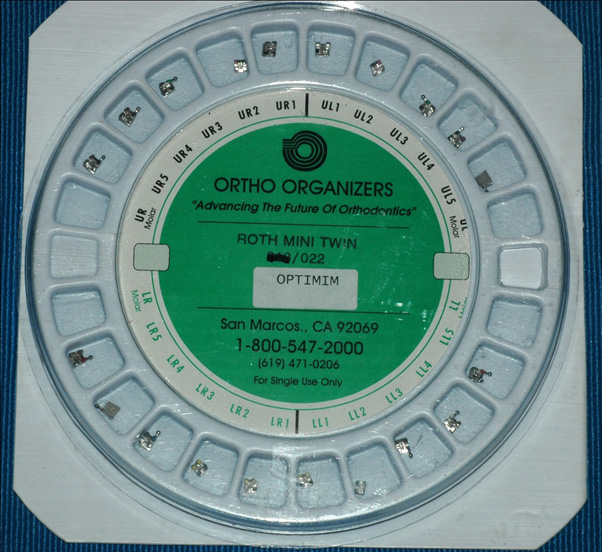
ForestadentTM(Pforzheim Germany),
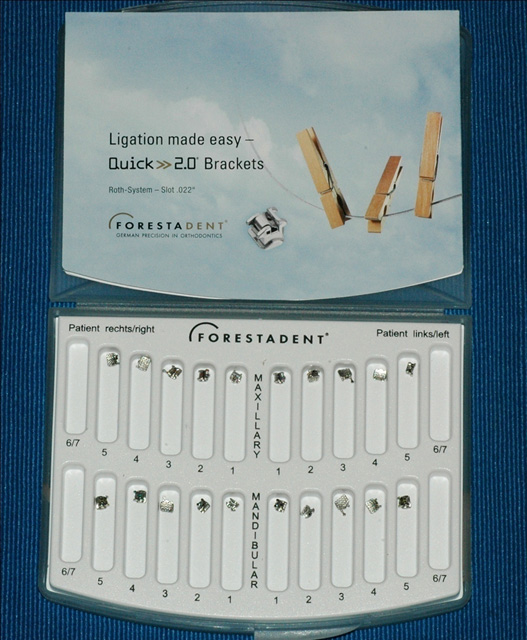
Damon 3 SLTM(Sybron dental specialities Ormcocorp California)
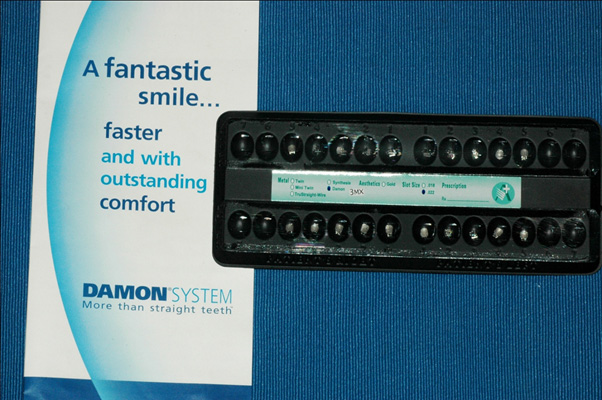
Materials and Methods
An experimental model which reproduced segments of maxillary and mandibular arches was used to assess the frictional forces which were produced by two types of brackets, self ligating brackets and conventional stainless steel brackets. A total of 12 rectangular blocks were of cold cure acrylic were made to fix the brackets. The buccal segment model consisted of 5 brackets for second premolar, first premolar, the canine, the lateral incisor and central incisor. A section of 0.019 x 0.025 inch stainless steel wire was used to align the brackets before fixing them with cyanoacrylate glue onto acrylic blocks [Table/Fig-4].
Experimental model showing in-vitro model of maxillary arch
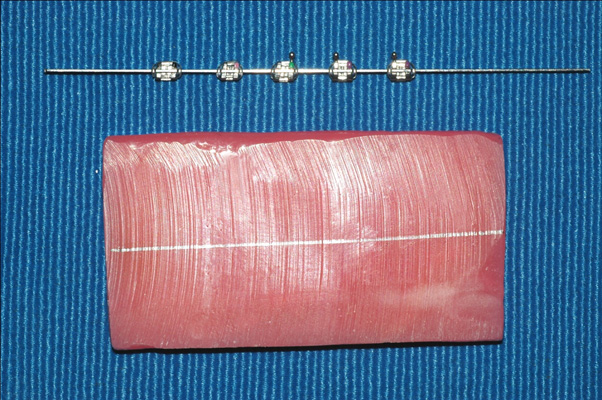
Methodology
A 10 cm straight length wire which had to be tested was placed into the bracket slot and it was ligated passively to the tie wings with elastomerics ligatures (TMOrtho Organizer USA) for conventional stainless steel brackets, and for the self ligating brackets, by closing the cap.
The friction which was generated by the testing unit, which consisted of the wire, brackets and ligation systems was measured under dry conditions and at room temperature by using an Instron testing machine TMInstron Corp, Canton, Mass which had a load cell of 10 N. The testing machine was caliberated by the Instron Caliberation Laboratory in terms of crosshead displacement/speed and load cell. The test wire was inserted into testing unit, its bottom end was clamped by a vise and it was mounted on machine crosshead. 10 cm length of archwire was used to prevent any distortion to bracket slots. [Table/Fig-5] Each bracket slot was cleaned with spirit and dried with compressed air before running each test. The test wire was pulled through the brackets at a speed of 0.5 mm per minute. The drawing force (P) was evaluated four times for each arch wire and bracket assembly on each occasion. A total of 192 tests were run. The load cell registers the force level which is needed to move the wire along the 5 aligned brackets and the levels are transmitted to computer.
Friction testing apparatus showing the ligated test wire into experimental model clamped to Instron Testing machine crosshead
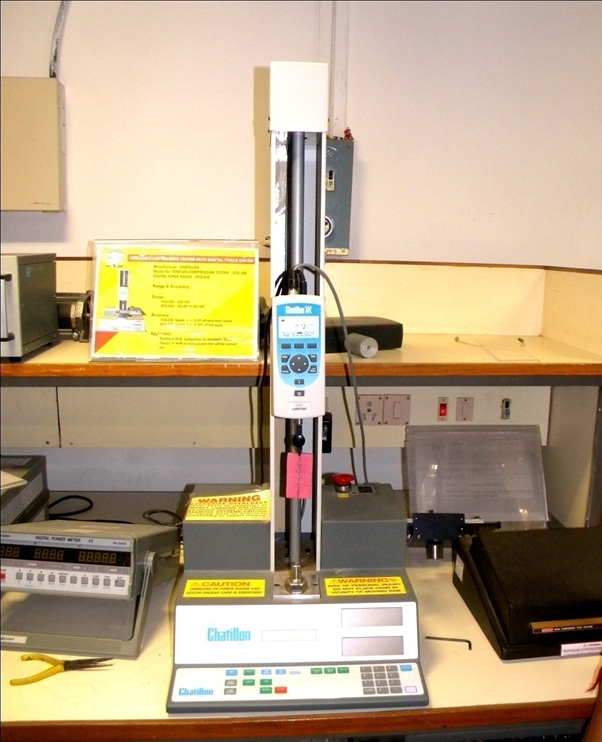
Statistical Analysis
Descriptive statistics, including mean, SD, median, minimum and maximum values were calculated for each bracket archwire combination. A one way ANOVA test was used to study the effect of the bracket type, wire alloy and section on frictional resistance test .In addition, pair wise comparisons at an overall significance level of 0.05, were made between the three types of brackets and four types of archwires by using Tukey’s method.
Results
The present study was carried out to evaluate the friction which was generated between conventional and self ligating brackets by using various arch wire combinations. Conventional brackets were ligated with elastomeric modules, whereas for Damon III and Forestadent brackets, a self ligating mechanism was used. In this study, factors influencing friction were studied;ligature and wire (levels), as has been stated below [Table/Fig-6].
| Factor | Levels |
|---|
| Ligature | Conventional Ligation Self Ligating Brackets(Active and Passive) |
| Wire | 0.016”NiTi,0.018”NiTi,0.017”x0.025”stainless-steel, 0.019” x 0.025” stainless-steel |
One way ANOVA test was used to study the effect of the bracket type, wire alloy and section on frictional resistance test, as has been shown in [Table/Fig-7]. A highly significant difference was found between the three bracket systems by using various archwire combinations (p-value<0.001). .In addition, pair wise comparisons were made at an overall significance level of 0.05, between the three types of brackets and four types of archwires by using Tukey’s method.
Comparison of frictional values between group I (conventional bracket system) group II (active bracket system) and group III (passive bracket system) using one way ANOVA test
| Group Mean | Sum of Squares | Df | Mean Square | F | Sig. |
|---|
| 0.016NiTi | Between Groups | 25.876 | 2 | 12.938 | 96331.008 | .000 |
| WithinGroups | .006 | 45 | .000 | | |
| Total | 25.882 | 47 | | | |
| 0.018NiTi | Between Groups | 24.755 | 2 | 12.378 | 25056.179 | .000 |
| Within Groups | .022 | 45 | .000 | | |
| Total | 24.777 | 47 | | | |
| 0.017x0.025SS | Between Groups | 46.610 | 2 | 23.305 | 32728.977 | .000 |
| Within Groups | .032 | 45 | .001 | | |
| Total | 46.642 | 47 | | | |
| 0.019x0.025SS | Between Groups | 69.249 | 2 | 34.625 | 9198.252 | .000 |
| Within Groups | .169 | 45 | .004 | | |
| Total | 69.419 | 47 | | | |
It can be seen from [Table/Fig-8], that Damon 3 SLTM (Sybron Dental Specialities Ormcocorp California) demonstrated the lowest friction for all dimensions of the test wire. Conventional bracketTm (OrthoOrganiser USA) produced the highest friction with all wire dimensions which were tested. ForestadentTM(Pforzheim Germany) SL and Damon 3 SLTM (Sybron Dental Specialities Ormcocorp California) showed no significant differences. With all the bracket systems, the 0.019 x 0.025 inch stainless steel wires produced highest friction. The mean forces of the both these self ligating brackets with 0.019 x 0.025 inch stainless steel were significantly different from conventional bracketTM (OrthoOrganiser USA) . With increase in wire dimensions, all the bracket types were found to be significantly different from each other, as can be seen in [Table/Fig-9].
Graph showing variation of mean friction with wire type and bracket
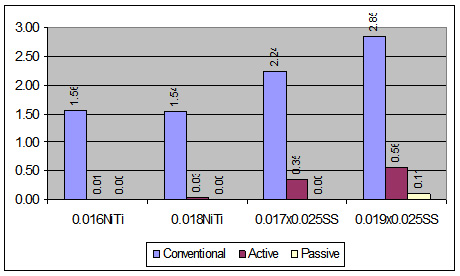
Turkey’s test statistical summary of friction data for all bracket/archwire combination
| Group Mean | 0.016NiTi | 0.018 NiTi | 0.017x0.025SS | 0.019x0.025SS |
|---|
| Conventional | Mean | 1.56 | 1.54 | 2.24 | 2.85 |
| S.D. | 0.04 | 0.03 | 0.09 | 0.14 |
| Max | 1.72 | 1.63 | 2.58 | 3.22 |
| Min | 1.50 | 1.50 | 2.01 | 2.44 |
| N | 64 | 64 | 64 | 64 |
| Active | Mean | 0.01 | 0.03 | 0.35 | 0.56 |
| S.D. | 0.02 | 0.06 | 0.03 | 0.06 |
| Max | 0.10 | 0.20 | 0.43 | 0.78 |
| Min | 0.00 | 0.00 | 0.31 | 0.47 |
| N | 64 | 64 | 64 | 64 |
| Passive | Mean | 0.00 | 0.00 | 0.00 | 0.11 |
| S.D. | 0.00 | 0.00 | 0.00 | 0.02 |
| Max | 0.00 | 0.00 | 0.00 | 0.13 |
| Min | 0.00 | 0.00 | 0.00 | 0.02 |
| N | 64 | 64 | 64 | 64 |
The results demonstrate a difference in the friction which was produced in self ligating brackets and elastomerically tied brackets.
Conventional brackets produced highest levels of friction for all bracket/archwire combinations. Both Damon III and Forestadent brackets produced significantly lower levels of friction as compared to electrometrically tied conventional brackets.
In the conventional brackets, the friction increased with increasing archwire dimensions. However, the use of elastomeric modules for ligation significantly increased the friction.
Friction increased with Forestadent brackets when the arch wire depth was greater than 0.017 inch, because of contact of the spring clip with archwire in the slot. With Damon self ligating brackets, friction was negligible at lower archwire dimensions and it was very low, even with a 0.019 x 0.025 inch rectangular archwire.
Effect of archwire size on frictional resistance was confirmed, that is, as the archwire size increased, the frictional resistance increased.
Discussion
This laboratory study was designed to compare the friction which was produced by various brackets and archwire combinations. Tipping and torquing forces can also affect the frictional resistance during space closure. However, these factors were not studied in this investigation. It must be remembered in any in vitro study, this investigation cannot reproduce what occurs clinically during orthodontic tooth movement, but great care was taken to ensure that the methodology was comparable with those of previously published works [12].
Frictional force has two components; the initial friction which occurs between the archwire and the bracket when a force is applied, is termed as static friction and it must overcome to initiate tooth movement. As the tooth moves, the second component of friction, which is termed as dynamic friction, occurs when the archwire moves in the direction of the applied force, as it is guided through the molar and premolar bracket slots. The cause of frictional resistance between archwires and brackets is multifactorial and it varies with archwire size and material [13–15], mode of ligation [12,16,17], bracket width [18,19] and wire to bracket angulation [7].
The present study was carried out to evaluate the friction which was generated between conventional and self ligating brackets by using various arch wire combinations. Conventional brackets were ligated using elastomeric modules, whereas a self ligating mechanism was used to ligate Damon III and Forestadent brackets. In general, the Damon self ligating brackets produced the lowest friction [Table/Fig-8]. Both self ligating systems consistently produced low levels of friction. Achieving ligation using an elastomeric module significantly increases the friction which is produced. This study supports the findings of previous investigations, which showed that a higher frictional resistance occurred with elastomeric ties as compared to self ligating mechanisms [12,16,20]. Sims et al., [12] (1993) investigated friction which was produced in two forms of self ligating brackets and in two methods which were used for ligating “A” Company Mini Twin brackets with polyurethane elastomeric ligatures. The results indicated that self ligating brackets required less force to produce tooth movement than conventionally tied Siamese brackets. Generally, friction appears to increase as archwire diameter increases [14,15] and the results of this investigation supported this view. With all three bracket types, the 0.019 x 0.025-inch stainless steel wire produced the highest friction. The frictional resistance was greater for the Forestadent brackets with 0.019 x 0.025-inch stainless steel wires than for Damon III self ligating brackets, for same dimension.
A study done by Gurmeet K et al., [21] (2013) concluded that passive self ligating mechanisms of smart clip and Damon3MX brackets showed the least values as compared to active self ligating mechanisms of Time 2 and Innovation R brackets. Similar results were found in this present study, in which Damon III passive self ligating bracket system demonstrated the lowest friction for all dimensions of the test wires [Table/Fig-7,9]. Forestadent Active self ligating bracket system demonstrated higher friction than Damon III passive self ligating system, which was probably related to special spring design. These findings were in agreement with those of previous studies that had compared the frictional properties of active and passive self ligating brackets [2,22,23,24,25]. Conventional bracket system produced highest friction with all wire dimensions which were tested. With all the bracket systems, 0.019 x 0.025 inch stainless steel wires produced highest friction. The results of the present study clearly highlight the effectiveness of newer generation passive self ligating brackets, almost as a friction-free alternative to conventional ligature systems. Passive, self ligating systems are undoubtedly the most efficient, as they show lower values of friction with respect to 0.019 X 0.025 inch stainless steel archwires as well. Future studies should incorporate test designs on similar lines as were employed by the present study, with additional parameters which can comparatively evaluate other alloy compositions against the interactive influence of the oral environment, especially saliva, so that a more complete and thorough clinical solution can be derived. Additionally, studies may also be carried out by using varying archwire dimensions which are clinically relevant, such as incorporating a 0.017 X 0.025 inch TMA archwire which is widely used in loop mechanics.
Conclusion
Reduction in frictional forces during sliding mechanics increases the efficiency of the orthodontic treatment. A myriad of innovations have been made to decrease frictional forces. Some of the most recent attempts which have been made, include the introduction of self ligating brackets and non conventional ligature systems.
This laboratory study measured the mean forces which were required to overcome friction which occurred with use of various brackets and archwire combinations.The results demonstrated a difference in the friction which was produced in self ligating brackets and elastomerically tied brackets. Considering the various aspects of the present study, it can be concluded that both the self ligating brackets showed negligible friction levels as compared to conventional ligations. Hence, SLBs are an ideal alternative to conventional ligations, for reducing friction.
[1]. Nanda R, Biomechanics in clinical orthodontics 1997 PhiladelphiaWB Saunders Company:50-51. [Google Scholar]
[2]. Hain M, Dhopatkar A, Rock P, The effect of ligation method on friction in sliding mechanicsAm. J. Orthod. Dentofac. Othop 2003 123:416-22. [Google Scholar]
[3]. Pizzoni L, Ravnholt G, Melsen B, Frictional forces related to self ligating bracketsEur J Orthod 1998 20:283-91. [Google Scholar]
[4]. Thomas S, Sheriff M, Birnie D, A comparative in-vitro study of the frictional characteristics of two types of self-ligating brackets and two types of pre- adjusted edge wise brackets tied with elastomeric ligaturesEur. J. Orthod 1998 20:589-96. [Google Scholar]
[5]. Henao SP, Kusy RP, Frictional evalutuations of dental typodont models using four self ligating designAngle Orthod 2005 75:75-85. [Google Scholar]
[6]. Tecco S, Festa F, Caputi S, Traini T, Di Iorio D, D’Attilio M, Friction of conventional and self-ligating brackets using a 10 bracket modelAngle Orthod 2005 75:1041-5. [Google Scholar]
[7]. Thorstenson GA, Kusy RP, Resistance to sliding of self-Iigating brackets verses conventional stainless steel twin brackets with second order angulations in the dry and wet saliva statesAm. J. Orthod. Dentofac. Orthop 2001 120:361-70. [Google Scholar]
[8]. Franchi L, Baccetti T, Camporesi M, Barbato E, Forces released during sliding mechanics with passive self-ligating brackets or nonconventional elastomeric ligaturesAm J Orthod Dentofacial Orthop 2008 133:87-90. [Google Scholar]
[9]. Franchi L, Baccetti T, Forces released during alignment with a preadjusted appliance with different types of elastomeric ligaturesAm J Orthod Dentofacial Orthop 2006 129:687-90. [Google Scholar]
[10]. Iwasaki LR, Beatty MW, Randall CJ, Nickel JC, Clinical ligation forces and intra oral friction during sliding on a stainless steel archwireAm J Orthod Dentofacial Orthop 2003 123:408-15. [Google Scholar]
[11]. Turnbull NR, Birnie DJ, Treatment efficiency of conventional vs self-ligating brackets: effects of archwire size and materialAm J Orthod Dentofacial Orthop 2007 131:395-99. [Google Scholar]
[12]. Sims AP, Waters NE, Birnie DJ, Pethybridget RJ, A comparison of the forces required to produce tooth movement in vitro using two Self ligating brackets and a pre adjusted bracket employing two types of ligationEur. J. Orthod 1993 15:377-85. [Google Scholar]
[13]. Tidy DC, Frictional forces in fixed appliancesAm. J. Orthod. Dentofacial. Orthop 1989 96:249-54. [Google Scholar]
[14]. Angolkar PV, Kapila S, Duncanson MG, Nanda RS, Evaluation of friction between ceramic brackets and wiresAm J Orthod Dentofacial Orthop 1990 98:499-506. [Google Scholar]
[15]. Kapila S, Angolkar PV, Duncanson MG, Nanda RS, Evaluation of friction between edgewise stainless steel brackets and orthodontic wires of four alloysAm.J. orthod. Dentofac. Orthop 1990 98:117-26. [Google Scholar]
[16]. Berger JL, The influence of SPEED bracket’s self-ligating design on force levels in tooth movementAm. J. Orthod. Dentofac. Orthop 1990 97:219-28. [Google Scholar]
[17]. Bednar JR, Gruendeman JW, Sandrik JL, A comparative study of factional forces between orthodontic brackets and arch wiresAm. J. Ortbod. Dentofac. Orthop 1991 100:513-22. [Google Scholar]
[18]. Frank CA, Nikolai RJ, A comparative study of frictional resistances between orthodontic bracket and arch wireAm. J Orthod. Dentofac. Orthop 1980 78:593-609. [Google Scholar]
[19]. Drescher D, Bourauel C, Schumacher HA, Frictional forces between bracket and arch wireAm J Orthod Dentofacial Orthop 1989 96:397-404. [Google Scholar]
[20]. Shivapuja PK, Berger J, A comparative study of conventional ligation and self- ligation bracket systemsAm. J. Orthod. Dentofac. Orthop 1994 106:472-80. [Google Scholar]
[21]. Kaur Gurmeet, Goyal Saurabh, Rajpal Sumeet, Gera Anil, Comparative evaluation of frictional forces of conventional and self ligating brackets system: An in vitro studyJ. Ind. Orthod.Soc 2013 47(4):339-42. [Google Scholar]
[22]. Thorstenson GA, Kusy R.P, Effects of ligation type and method on the resistance to sliding of novel orthodontic brackets with second-order angulation in the dry and wet statesAngle Orthod 2003 73:418-30. [Google Scholar]
[23]. Ehsani Sayeh, Mandich Marie-Alice, Tarek H. El-Bialy, Carlos Flores-Mir, Frictional Resistance in Self-Ligating Orthodontic Brackets and Conventionally Ligated Brackets-A Systematic ReviewAngle Orthodontist 2009 79(3):592-601. [Google Scholar]
[24]. Stefanos Sennay, Antonino G. Secchi, Guy Coby, Tanna Nipul, Francis K. Mante, Friction between various self-ligating brackets and archwire couples during sliding mechanicsAm.J.Orthod. Dentofac. Orthop 2010 138(4):463-7. [Google Scholar]
[25]. Sfondrini Maria Francesca, Fraticelli Danilo, Rosti Federico, Scribante Andrea, Gandini Paola, Frictional Properties of Self-Ligating Brackets and Low-Friction LigaturesCurrent Research in Dentistry 2012 3(1):1-6. [Google Scholar]